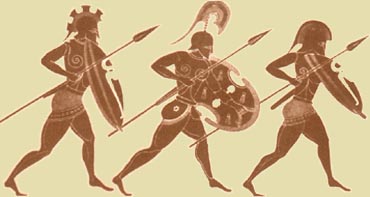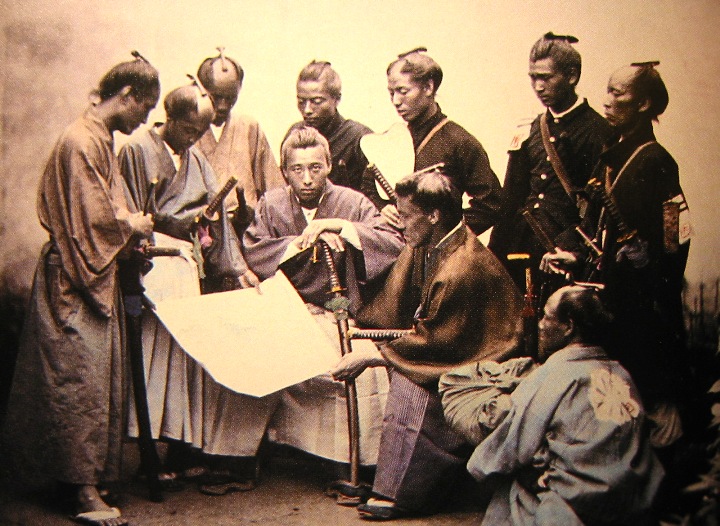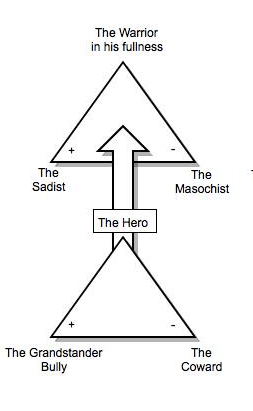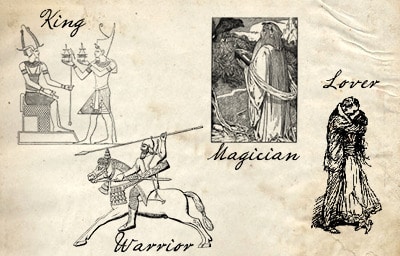
This is the fourth part of a series on the archetypes of mature masculinity based on the book King, Warrior, Magician, Lover by Robert Moore and Douglas Gillette. If you haven’t already, I highly recommend reading the introduction to the series first. Also, keep in mind that these posts are a little more esoteric than our normal fare, and are meant to be contemplated and thoughtfully reflected upon.
Every great civilization has a great warrior tradition and accompanying warrior myths. The Old Testament recounts the stories of a warrior people and a warrior God. In the ancient Mediterranean, the Spartans had perhaps the most legendary warrior tradition. From birth, Spartan society nurtured and trained their boys to become warriors, and that rigorous training created men like Leonidas and his 300 men of unconquerable spirit. Japan had their fearless samurai warriors whose undaunted courage came from living life as if they were already dead.
Today the Warrior archetype lives on in our reverence for those who serve in the armed forces and in modern books and movies. William Wallace from Braveheart and General Maximus from Gladiator embody the Warrior archetype.
But in general, modern culture is not comfortable with Warrior energy. The advent of mechanized warfare during the first half of the 20th century dampened the romantic ideal of martial courage. Since the social and cultural revolutions of the 60s and 70s, we’ve generally taught boys and men to avoid confrontation and conflict and to instead nurture their “feminine side.” The result is the Nice Guy; the man who will avoid confrontation and aggression even when confrontation and aggression are justified.
Society pushes men to be sweet and sensitive, because they fear them becoming coldly stoic, abusive, and destructively angry. But society’s perception of the Warrior archetype is not based on the Warrior energy in its full, healthy manifestation, but on the archetype’s shadows. The problem is not Warrior energy itself, but Warrior energy that is not used in harmony with the other masculine archetypes and directed by empathy, contemplation, and order. Fighting itself is not bad, the question is simply: What is a man fighting for? The Warrior’s energy is needed not only in times of war, but on all the battlefields of life.
Properly tapping into the Warrior’s energy provides a man with an unsurpassable power source which will fuel him to reach his goals, fight for worthy causes, achieve greatness, and leave a lasting legacy.

The Warrior in His Fullness
Moore says that “The characteristics of the Warrior in his fullness amount to a total way of life, what the samurai called a do (pronounced ‘do’). These characteristics constitute the Warrior Dharma, Ma’at, or Tao, a spiritual or psychological path through life.”
What are these characteristics? Let’s take a look.
Note: While here we use the language of the martial warrior, the characteristics can be applied to any man’s life mission, whether civilian or true solider.
Aggressive
If you look up the word “aggressive” in the dictionary, these are the definitions you’ll find:
1. characterized by or tending toward unprovoked offensives, attacks, invasions, or the like; militantly forward or menacing2. making an all-out effort to win or succeed; competitive3. vigorously energetic, especially in the use of initiative and forcefulness
Of the three definitions, the first is most popular in modern culture. Something unprovoked, out of line. Notice how often “overly” precedes “aggressive” in common parlance. Aggression may also bring to mind military policies a person does not agree with. In general it has a negative connotation.
But true aggression should be thought of in the context of the second two dictionary entries. Effort. Energy. Initiative. Force. Aggression is a neutral tool that can be harnessed for either ill or good. How it is channeled makes all the difference. A man who does not harness his aggression at all picks a fight with everyone and about everything; his relationships fail and he is stunted in his personal development. The man who reins in his aggression too much becomes the stereotypical weenie Nice Guy–proper aggression turns into passive aggression. He is too “polite” to go after what he wants, and he’s seething inside because of it. A man who has successfully integrated the Warrior archetype harnesses his aggression as the force that pushes him to compete to be the best and moves him ever forward towards his goals.
Purpose
Of course that proper use of aggression presupposes that a man has goals that he’s striving towards in the first place. A man has to have a clear and definite purpose in life, or he will feel lost and restless, like he is drifting along instead of marching ahead.
Mindful
The mindfulness of the Warrior is two-fold. First, he is always alert and awake, ever vigilant. He has keen situational awareness. He never lets complacency lull him to sleep; instead, he is always watching, observing, studying, and planning. Secondly, the Warrior is mindful of the finiteness of life and the inevitably of death, and he purposefully contemplates that death. His courage is rooted in the fact that he is not afraid to die. Life’s shortness brings clarity to his mind. He knows that any minute could be his last so he makes every day and decision count. Carpe diem! becomes his battle cry.
Adaptable
During the Revolutionary War, the Continental Army knew that it could not match the man and fire power of the British. So instead of facing them down on a field for a traditional battle, the minutemen took to the woods and launched surprise hit and run attacks on the enemy. This is the way of the Warrior; he is a guerrilla fighter. When he’s up against great odds, he bucks convention and uses his cleverness and his strategic intelligence to find creative ways to turn the tide in his favor. He is an efficient fighter–he studies the weaknesses of his opponents and concentrates his strikes there. He is flexible and able to respond to change by shifting tactics on the fly.
Minimalist
The key to successful guerrilla warfare is the fighter’s ability to travel light. While the traditional force has power in its superior resources, those resources also weigh and slow them down. The guerrilla fighter strips away all superfluities and excess baggage; he carries only what he needs and is thus quick and nimble, able to be two steps ahead of the enemy.
Decisive
In times of peace or crisis, whether for big things or small, the Warrior is able to boldly make decisions. He doesn’t stand there shilly-shally, wondering what he should do, scared of choosing the wrong option. He is calm and cool under pressure. Once he makes a decision, he unhesitatingly moves on it because he does not live in regret. The Warrior is able to be so decisive because he trains so thoroughly for these moments; he is prepared. He thinks about all possible contingencies and what he would do in each situation before the crisis arrives. When the crisis does come, his mind and body already instinctively know what to do.
Skillful
Part of the Warrior’s confidence in his decisions is rooted in his supreme competence. Accordingly to Moore, “The Warrior’s energy is concerned with skill, power, and accuracy.” The Warrior “has absolute mastery of the technology of his trade…the technology that enables him to reach his goal. He has developed skill with the ‘weapons’ he uses to implement his decisions.”
Loyal
If you remember, the Hero is the boyhood archetype which matures into the Warrior archetype. Part of this maturation process centers on a shift in a man’s loyalties. Moore argues that “The Hero’s loyalty…is really to himself–to impressing himself with himself and to impressing others.” The Warrior’s loyalties, on the other hand, “are to something beyond and other than himself and his own concerns.” The Warrior’s loyalty centers on “a cause, a god, a people, a task, a nation–larger than individuals.” The Warrior has a “central commitment” around which he organizes his life. His life’s purpose is rooted in ideals and principles, which naturally strips away superfluities and pettiness and brings his life great meaning.
Disciplined
The Warrior has mastered himself in body and mind. His power is rooted in self-control. He knows when to be aggressive and how aggressive to be. He is the master of his energies, releasing them and pulling them back as he chooses. He decides the attitude he will take in a certain situation, instead of letting the situation dictate how he feels. Unlike the boyhood Hero archetype, the Warrior understands his limits; he takes calculated instead of unnecessary risks. His discipline also frees him of a fear of pain. Feeble, mediocre men believe all pain is bad. The Warrior knows there is bad pain and good pain. He is willing, even eager to withstand psychological and physical pain on the path to his goals. He’s the kind of man who subscribes to the “pain is just weakness leaving the body” philosophy; he relishes difficulty because it makes him stronger.
Emotionally Detached
Not all the time, but when he is in Warrior mode. To complete his mission, the Warrior must be emotionally detached–from the fear and doubt generated by his own feelings, from the intimidation emanating from his enemy, and from the “shoulds” and demands put on him by friends and family. The Warrior needs the kind of mental clarity that only comes from single-minded purpose, or as Moore puts it, “The Warrior needs room to swing his sword.”
Switching off that emotional detachment when away from the mission represents the great challenge for the Warrior. The inability to do so can result in one of the Warrior’s shadows.
Creative Destroyer
The Warrior is the archetype of destruction. However, the Warrior in his fullness only destroys in order to “make room for something new and fresh and more alive.” His is an act of creative destruction–he doesn’t tear things down simply for the pleasure of doing so. We call upon the Warrior archetype when we quit bad habits and replace them with better ones or when we get rid of people in our lives who bring us down and surround ourselves with people who edify.

The Shadows
The Sadist. As just discussed, men in touch with the Warrior archetype have the ability to detach themselves from emotions and human relationships. While detachment provides a man with much needed focus on important tasks, when it becomes a man’s permanent state, the Sadist shadow controls a man’s psyche.
This is why soldiers, who have a mission-minded attitude while on deployment, can find it very difficult to adjust to life back home and find their place in their families, which are based on emotional needs and currents–the stuff the solider has been used to setting aside. The mission-focused life freed him from human pettiness–and returning to it can be grating. This is also true of lawyers, ministers, doctors, politicians, and other men who may be married to their job–shifting from mission-mode to domestic-mode can be difficult for them.
As the name implies, the Sadist can be cruel, even to those most vulnerable. He disdains the weak. A commanding officer in the Army may try to rigidly run his family in the same way that he led his troops. The Sadist creates unattainably high standards for himself and those around him. When a child comes home with a less than perfect grade, a father influenced by the Sadist will put her down and berate her mercilessly. A man with positive Warrior energy would have kindly shown disappointment, but then offered to help his daughter study for the next exam so she could ace it.
The Sadist’s disgust at weakness is linked to the boyhood Hero archetype. The Hero tries to break away from his mother and from feminine energy in general as he seeks to become his own man. But adult men who are still insecure about being “man enough” project this insecurity onto others. He hates what he fears is within himself.
According to Moore, men possessed by the Sadist also tend to be workaholics. They’re the men who take pride in working all night at the office and coming home at 7AM, only to leave for the office again an hour later. They’ll choose work at the expense of health and even family. They take the Warrior’s comfort with pain to an extreme and grind it out to get to the top. But they’re doing it because they really don’t know what they want out of life, and constantly working distracts them from this fact. Once they do reach the top, they often feel empty, lost, and bitter. But many Sadists simply burn out before they even get there.
The Masochist. The Masochist is the passive shadow in the tripartite Warrior archetype, and its attributes closely parallel those of the boyhood Hero archetype’s cowardly shadow. A man possessed by the Masochist feels he is powerless. He is a push-over who has no personal boundaries and will let others walk all over him. He may hate his job or the relationship he’s in and complain about it, but instead of quitting, cutting his losses and moving on, he digs in and tries harder to be who his boss or girlfriend wants him to be and takes even more abuse. Because while he might complain about the pain, he really likes it. This is the man who enjoys being the martyr.
An archetype’s bi-polar shadows often work together against a man. Men under the Masochist’s influence will take the disrespect others dish out without fighting back or asserting themselves. Then one day something, maybe a criticism from his wife, pushes him over the edge and he “explodes with sadistic verbal [and sometimes even] physical abuse.”
How to Access the Warrior Archetype
Many men today lack Warrior energy. They’ve been told all their lives that aggression is bad and they should just work on being be “nice guys.” But if there’s anything the world needs today, it’s men in touch with the Warrior archetype. It’s the energy that propels men to dare greatly and to fight for a worthy cause. So what can we do to access this positive Warrior energy?
Watch movies about great warriors. Yeah, it’s cliche, but it works. They don’t necessarily have to be war movies. Any film that showcases men with the warrior spirit will do. Here are a few of my favorite warrior movies. I’d love to read yours:
- Braveheart
- Gladiator
- The Seven Samurai
- Last of the Mohicans
- Shane
- Glory
- Patton
Read biographies about great warriors. Also, dig into writings like those of Marcus Aurelius (the ultimate philosopher-warrior).
Take up boxing or another martial art.
Work on becoming more decisive.
Meditate. Especially on death.
Quit shoulding on yourself. The Warrior is able to detach himself from the opinions of others in order to carry out his mission.
Have a plan and purpose for your life.
Boost your adaptability by strengthening your resilience.
Study and practice the skills necessary for completing your goals. Whether that’s marksmanship, computer programming, or being charismatic, become a master of your trade.
Find the principles that you’re loyal to.
Establish some non-negotiable, unalterable terms (or N.U.Ts) and live by them.
Compete in a race like the Warrior Dash. It’s got the word warrior right in the name!
Strengthen your discipline by establishing habits and daily routines.
Adopt a minimalist philosophy. Declutter your life. Simplify your diet. Get out of debt.
The Four Archetypes of the Mature Masculine:
Introduction
The Boyhood Archetypes – Part I
The Boyhood Archetypes – Part II
The Lover
The Warrior
The Magician
The King







